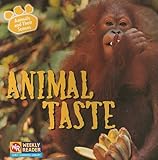Lesson 1: Identifying Information
Lesson Plan
Animal Taste

- Learning Goal
- Identify explicit information in nonfiction.
- Duration
- Approximately 50 minutes
- Necessary Materials
- Provided: Example Chart, Independent Practice Worksheet
Not Provided: Animal Taste published by Weekly Reader, chart paper, markers
-
Teacher Modeling

will explain that we read nonfiction books when we want to learn new information. I will read Animal Taste aloud through page 13 and chart the information I learn from the pictures and words (example provided).
-
Think Check
Ask: "How did I learn information from a nonfiction book?" Students should respond that you read the book and looked at the pictures and charted the information you are learning. This information was right there in the book.
-
Guided Practice

will continue reading Animal Taste and chart the information we learn from the pictures and words in the book (example provided).
TIP: Discuss specific examples found in the book during the Guided Practice and ask students to help you identify explicit information: What did we just learn on this page about how a snake eats?
-
Independent Practice

will identify the information you learned from the text. You will draw a picture of what you learned. (Independent Practice Worksheet is provided.) Note: Use the Informational Genre Unit, together with the Explicit Information Unit, to teach the skill of gathering information from books.
Texts & Materials
Standards Alignment
(To see all of the ReadWorks lessons aligned to your standards, click here.)


